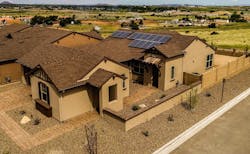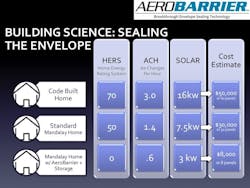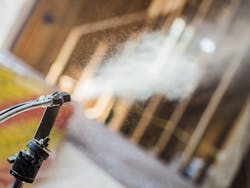AeroBarrier is the Key to Mandalay Homes Constructing 3,500 Carbon-Neutral Homes in Arizona
Prescott, Arizona
For the past five years, Mandalay’s Founder, Dave Everson, was on a mission to scale carbon-neutral (or zero-energy) homes, and offer them as a standard feature on every home they sell. The challenge is making such homes economically feasible and scalable.
Most often, the zero-energy formula is to load a rooftop full of solar panels and ignore budget. For a typical code-built, 2000 square foot home, approximately 60 solar panels are needed to achieve net-zero, at a cost of $60,000.
The ACH (Air Changes per Hour)
There is a direct correlation between a lower ACH and fewer solar panels need for net-zero. The ACH dictates mechanical load design and related energy demands. The higher the ACH, the greater the energy demands. A home built to IECC 2012 standards, in Climate Zone 5, has an ACH of 3.
When engineering for a lower ACH, less energy is required for operating the home.
The Economics
For Everson, he was able to perfect the building envelope with advanced framing and insulation techniques. In 2012, a typical Mandalay home tested at a 74 HERS Index. By 2016, Everson had pushed the performance of a typical Mandalay home to a 50 HERS Index. But, no matter how disciplined Mandalay was on insulation and envelope sealing strategies, they could not attain better than a 1.4 ACH. Although, this number is significantly better than code, it would still mean 30 solar panels are required to attain net zero. At a cost of almost $30,000, the price tag would not Everson to offer a net-zero home as a standard feature.
Advanced Sealing Technology − a Lower ACH
In 2017, AeroBarrier announced beta-testing for advanced envelope sealing technology. AeroBarrier claimed a process that is quick to apply, seamless in scheduling, economically feasible, and not vulnerable to workmanship error. Error, meaning the performance quality is not dependent on workmanship or the install techniques of a trade.
For the beta-test and pilot projects, Everson was first in line. The result, the AeroBarrier application reduced the typical Mandalay home from an ACH of 1.4 to .6.
With this, Everson had cracked the energy + homebuilding conundrum, coming one step closer to offering net-zero homes as a standard feature.
Battery Storage
Around the time of applying AeroBarrier to the first Mandalay home, Everson was experimenting with battery storage. Impressed by their market presence in Germany, high storage capacity, and 28-year battery life, Everson selected sonnenBatterie for energy storage. The result of marrying AeroBarrier technology with sonnen storage, resulted in needing only 8 solar panels to achieve net-zero on a typical 2000 sf Mandalay home. Compare this with a typical code built home, and its need for 60 solar panels to achieve net zero. The cost difference between 60 and 8 solar panels is $50,000.
The Birth of a Carbon Neutral* Community
After five years of Everson’s determination, and with the help of technology advancements and market competitiveness, Mandalay has broke ground on 3,500 carbon-neutral homes in the master-planned community of Jasper. Everson states, “At Mandalay, we believe the catalyst to the carbon-neutral community is AeroBarrier and it will be used on every home we build.”
*Carbon footprint is based only on estimated building energy use.
About AeroBarrier
AeroBarrier is the result of work at University of California, Davis, where it received four years of research and development. In 2017, AeroBarrier launched in beta, with its first use on projects that qualify for the DOE’s ZERH program.
AeroBarrier is especially useful on single and multi-family projects that need to meet the stringent performance requirements of LEED, ZERH, Passive House, and the 2015 IECC. Official launch is scheduled for 2018. For builders that qualify, AeroBarrier is making the beta program available immediately.
About Mandalay Homes
Founded in 1999, Mandalay is recognized as one of the most innovative builders in America. A seven-time winner of the DOE’s award for innovation, Mandalay is committed to building homes that promote safety, health, reduced energy costs, and less environmental impact. For every 7,000 Mandalay homes built with AeroBarrier, the equivalent of 100M pounds of coal burned will be saved compared to typical construction. Source: epa.gov.
AeroBarrier Contact Information
AeroBarrier
www.aerobarrier.net
Paul Springer, Manager – Business Development
[email protected]
937.428.9300 ext. 336


